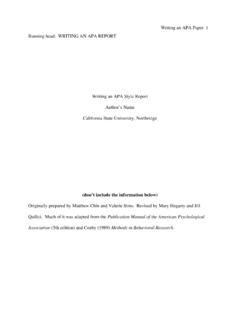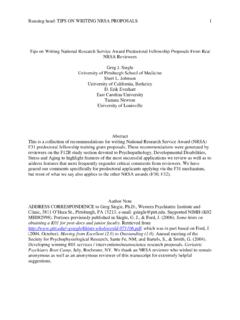Transcription of Group versus Individual Approach 1 Running head: Group ...
1 Group versus Individual Approach 1. Running head: Group versus Individual Approach Group versus Individual Approach ? A Meta-Analysis of the Effectiveness of Interventions to Promote Physical Activity Shauna M. Burke1, Albert V. Carron1, Mark A. Eys2, Nikos Ntoumanis3, & Paul A. Estabrooks4. 1. The University of Western Ontario; 2 Laurentian University; 3 The University of Birmingham;. 4. Kaiser Permanente Colorado The published version is in: Sport & Exercise Psychology Review Vol 2 No 1 13. The British Psychological Society 2006 ISSN 1745 4980.
2 Group versus Individual Approach 2. Abstract The purpose of the study was to conduct a meta-analysis to empirically compare the relative merits of different contexts typically employed in the physical activity intervention literature for five categories of outcomes: adherence, social interaction, quality of life, physiological effectiveness, and functional effectiveness. Four contexts were examined: home- based programs not involving contact from researchers or health-care professionals, home-based programs that involved some contact, standard exercise classes, and exercise classes where Group -dynamics principles were used to increase cohesiveness ( true groups ).
3 Standard literature searches produced 44 relevant studies containing 214 effect sizes. Results revealed a common trend across dependent variables; exercising in a true Group was superior to exercising in a standard exercise class, which in turn, did not differ from exercising at home with contact. Furthermore, exercising at home with contact was superior to exercising at home without contact. These results have implications for practitioners in terms of the importance of contact and social support in physical activity interventions. Key Words: meta-analysis, physical activity, exercise interventions, Group -based, home-based, adherence Group versus Individual Approach 3.
4 Group versus Individual Approach ? A Meta-Analysis of the Effectiveness of Interventions to Promote Physical Activity Physical activity plays an important role in health promotion and the prevention, delayed onset, and management of many adverse chronic health conditions (British Heart Foundation National Centre for Physical Activity and Health [BHFNC], 2005; Department of Health and Human Services [USDHHS], 2000). Similarly, the psychological benefits of sustained physical activity are well documented (Hausenblas, Dannecker, & Focht, 2001). In fact, although physical inactivity is related to 37% of deaths resulting from heart disease in the United Kingdom, the majority of British adults are not physically active at frequency and intensity levels that are sufficient to result in health benefits or disease prevention (BHFNC, 2005).
5 Thus, there is an ongoing interest in developing protocols to stimulate involvement in and maintenance of physical activity a daunting task considering that approximately 20-50% of adults who begin a structured exercise program will withdraw from the program within the first 6 months (Dishman, 1988; Oldridge, 1984; Ward & Morgan, 1984). The numerous benefits, low prevalence, and high attrition associated with physical activity have stimulated the development of a number of interventions and strategies to promote regular physical activity. This is evidenced by reviews of the literature on physical activity promotion in communities (Atienza, 2001; Hillsdon, Thorogood, Anstiss, & Morris, 1995; Kahn et al.)
6 , 2002; King, Rejeski, & Buchner, 1998), worksites (Dishman, Oldenburg, O'Neal, &. Shephard, 1998; Proper et al., 2003), health-care settings (Ashenden, Silagy, & Weller, 1997;. Eaton & Menard, 1998; Eden, Orleans, Mulrow, Pender, & Teutsch, 2002), or a combination of settings (Dishman & Buckworth, 1996; Holtzman et al., 2004; Marcus, Owen, Forsyth, Cavill, &. Fridinger, 1998). In a recent comprehensive review, the United States Task Force on Group versus Individual Approach 4. Community Preventive Services examined more than 100 studies on informational, behavioural/social, and environmental/policy approaches to promoting regular physical activity (Kahn et al.
7 , 2002). Relative to these approaches, the authors concluded that there was strong evidence both for the effectiveness of community wide campaigns, school-based physical education, social support interventions delivered in communities, individually tailored interventions, and for providing access to physical activity resources (Kahn et al., 2002). Even with the success of a number of intervention strategies, one fundamental consideration pertaining to any protocol aimed at increasing physical activity is the context that ought to be emphasized. The most common contexts for physical activity are either Group -based ( , structured classes) or individually-based ( , home-based; Iverson, Fielding, Crow &.
8 Christenson, 1985). This contextual distinction can be made regardless of the setting of intervention. For example, a health-care system may offer Group -based educational classes or Individual counseling for physical activity. Similarly, a worksite may offer an individually targeted Internet intervention or regular fitness classes to promote physical activity. Which of these two basic contexts ( , Group -based versus individually-based) is superior in terms of Individual adherence to physical activity programs has been the focus of considerable research attention and some controversy ( , Atienza, 2001; Carron, Hausenblas, & Mack, 1996.
9 Dishman & Buckworth, 1996; King, Haskell, Taylor, Kraemer, & DeBusk, 1991). Three reviews of literature serve to illustrate the nature of the controversy. In one, support was shown for the efficacy of Group -based interventions ( versus individually-based programs). Dishman and Buckworth (1996) empirically synthesized the results from 127 studies containing approximately 131,000 participants who were targeted with physical activity interventions in community, school, worksite, home, and health-care settings. Group versus Individual Approach 5. Interventions delivered to groups ( , in a Group setting) yielded much larger effects (r =.
10 75) in comparison to interventions delivered to individuals ( , one-on-one, with little contact from other participants; r = .16), to the family ( , with Individual family members and/or an entire family; r = .05), and to individuals within a Group ( , participants receiving Individual attention in addition to participation in Group activities; r = .04). In a second review, the efficacy of home-based interventions ( versus Group -based programs) was endorsed. Atienza (2001), on the basis of his narrative review of 39 studies (containing 3,626 participants), concluded that, exercise adherence in community samples was higher for home-based aerobic exercise compared to Group -based exercise (p.





